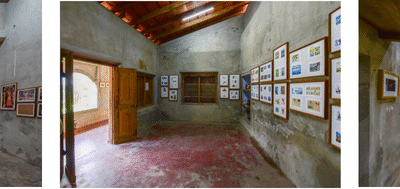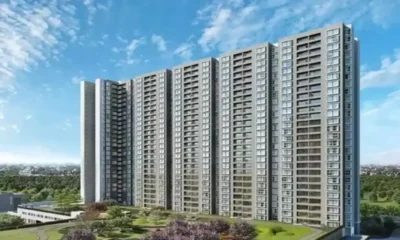News
Groundbreaking Report Maps $70 Bn Market for Green Building Materials in India

New Delhi, July 31, 2025: As India stands on the brink of an unprecedented construction boom set to double the nation’s current built-up area by 2050, green building materials (GBMs) are emerging as a compelling alternative to conventional, high-emissions materials such as cement and steel, creating an opportunity to decarbonise the construction sector.
In a bid to catalyse broader adoption of GBMs, Villgro Innovations Foundation and Habitat for Humanity’s Terwilliger Center for Innovation in Shelter, with the support of Saint-Gobain and knowledge partner Terrarium, have released a report titled “Accelerating Innovations in Green Building Materials in India”.
Building on a nationwide market study that combined secondary research data with inputs from 100-plus stakeholders, the report maps the current landscape and emerging innovations in sustainable construction materials across India.
The construction sector is responsible for a whopping 25 per cent of India’s total emissions and is projected to emit 90 billion metric tonnes of CO₂ between 2020 and 2070 if current practices continue. Without bold shifts in how we build, India risks embedding high-carbon choices into the nation’s infrastructure for decades, posing a major threat to its broader climate action goals and net zero by 2070 aspirations.
This is where green materials, such as fly ash bricks, fibre panels, waste-based pavers and geopolymer concrete, come in. The report shows that these materials are increasingly being seen by the construction sector as viable alternatives with lower embodied carbon and improved thermal performance.
These changing perceptions are helping expand India’s GBM market,projected to grow at a compound annual growth rate of 10-12 per cent, reaching $70-$80 billion by 2030, according to McKinsey.
Low-carbon, resource-efficient GBMs, if scaled and mainstreamed, can significantly reduce emissions and lower the construction sector’s carbon footprint while simultaneously supporting the growing need for affordable housing and infrastructure development. The groundbreaking report, however, positions GBMs as more than a climate-positive solution, highlighting the overlooked social, economic and environmental opportunities they offer.
Taken together, the report finds that GBMs represent a “triple-win for India: advancing climate action, enabling greener economic pathways and creating dignified green jobs”.

“We at Villgro, along with Habitat for Humanity’s Terwilliger Center, are pleased to unveil the new report, which sheds light on the momentum and current market landscape of GBMs in India, and outlines actionable pathways to strengthen and scale the GBM-centric innovation ecosystem,” said Ananth Aravamudan, CTO, Villgro.
“While most conventional construction methods are resource-intensive and environmentally unsustainable, GBMs, on the other hand, are not just climate-aligned, they’re also increasingly competitive vis-à-vis performance, durability and ease of use.”
In fact, if scaled strategically, he added, GBMs can become a critical lever to minimise the construction sector’s carbon footprint while unlocking inclusive growth, new livelihoods and resilient infrastructure.
“The time has come for India now to move from fragmented pilots for GBMs to coordinated systems-level changes, anchored in unified certification, accessible financing, integrated skilling and green-aligned public procurement, and this report hopes to serve as a call-to-action towards enabling us to move ahead in that direction.”

Anoop Nambiar, Country Director, Terwilliger Center India, said, “Sustainable development and climate change are closely intertwined. Growing aspirations and economic progress are fuelling demand for large-scale infrastructure as well as housing. In parallel with the need for resource efficiency and responsible consumption, the market for green building materials is expanding rapidly.”
He added, “Our research offers an in-depth analysis of this ecosystem, highlighting critical challenges and actionable pathways to promote sustainable and resilient construction practices.”

Venkat Subramanian, MD, Gypsum, Insulation & Mortars, Saint-Gobain, said, “Saint-Gobain is very happy to be a part of this report in accelerating innovation in green building materials in India. Saint-Gobain’s mission is to be a market leader in light and sustainable construction, and with the ambition of achieving net zero carbon emissions by 2030, our purpose of “Making the world a Better Home” aligns towards this cause.”
He added, “We have been associated with various green building materials, certifications and communications, and this market study report helps us to engage deeper with this purpose. We hope to see a transformation in the marketplace towards a low-carbon infrastructure and a sustainable future.”
Notably, one of the report’s key focus areas is innovation, specifically how the sustainable construction sector has become a fertile ground for entrepreneurial disruption with start-ups and early-stage enterprises at the forefront.
To this end, the report details multiple start-up success stories—through case studies of start-ups such as Zerund, Strawcture, RecycleX, Tvasta, Paving+, SatiQ, CarbonStrong, Angrius, CarbonCraft, Modroof and others—that prove that GBMs are viable, scalable and ready for mainstream adoption.
These start-ups are innovating and offering breakthrough solutions across geopolymer cement, 3D-printed construction, waste-based tiles, bio-based insulation and many other niche areas—especially segments that developers and traditional industry players often overlook.
Despite the changing sentiments documented in the report, mainstream adoption of GBMs in India remains limited due to systemic barriers relating to regulation, low awareness, certifications and testing along with high costs (premium pricing) of green materials and fragmented, insufficient incentives.
With a forward-looking lens, the report proposes a four-pillar actionable framework to overcome these roadblocks and build a resilient GBM innovation ecosystem in India with investable, scalable startup-led innovations at the core.
These four pillars, which are designed to comprehensively address existing market gaps in terms of innovation, validation and market linkages, and drive demand and adoption of GBMs in India, include:
● Forming an inclusive coalition to bring together government bodies, corporates and supply chain actors to align on green procurement norms, corporate net-zero commitments and logistics networks.
● Introducing a green material innovation fund for providing catalytic capital to support R&D and pilot deployments and strengthen the supply chain.
● Establishing a centre of excellence for testing and training to formulate national standards, promote low-cost testing and offer capacity-building programs for architects, engineers, and masons.
● Creation of a marketplace platform to showcase verified GBMs, connect suppliers with potential buyers (developers, contractors, institutions) and promote transparent procurement.

 News2 weeks ago
News2 weeks agoInfrastructure Automation Company Enlite Launches World’s First Patented Edge Controller for Intelligent Infrastructure

 News2 days ago
News2 days agoTWH Hospitality Announces Aggressive F&B Expansion Plan with ₹30 Cr Investment

 News2 weeks ago
News2 weeks agoIshara Art Foundation to Present Group Exhibition ‘Amphibian Aesthetics’ at Ishara House in Kochi

 News2 weeks ago
News2 weeks agoGodrej Properties Crosses FY26 Annual Business Development Guidance with Acquisition of 75-acre land parcel in Nagpur

 News3 weeks ago
News3 weeks agoMumbai Returns to Pre-Pandemic Investment Levels, Surpasses $1 Billion 4th Consecutive Year: Cushman & Wakefield

 News3 weeks ago
News3 weeks agoGurugram Premium Segment Drives Projected Rs 6.65 Lakh Crore Market: ANAROCK

 News2 weeks ago
News2 weeks agoK2 Infragen Delivers Robust H1 with 76.5% Revenue Growth, 70% Profit Jump

 News2 weeks ago
News2 weeks agoReal Estate Investment Momentum in APAC, India to Hold Steady Through 2026: Colliers’ Survey Insights



























